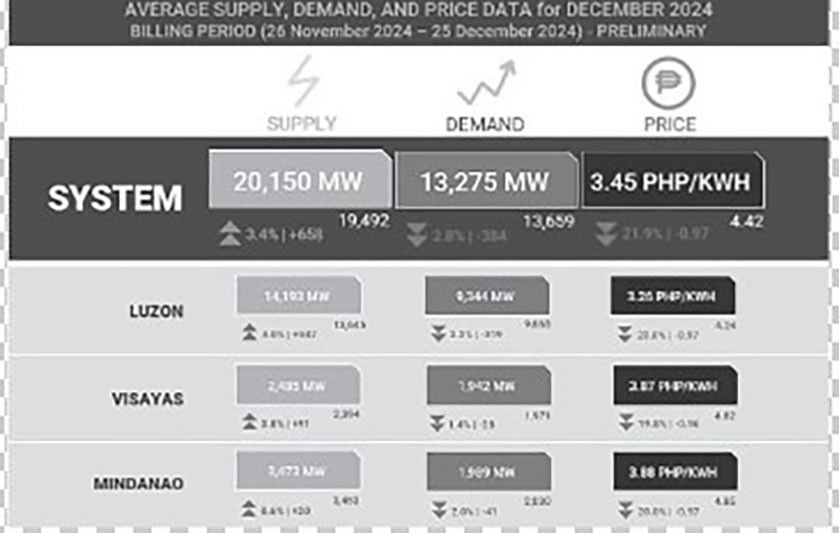Lower unemployment, inflation and electricity prices

Last week, the Philippine Statistics Authority (PSA) released the labor data for November 2024, with the unemployment rate at 3.2 percent – an all-time low except in June 2024 and December 2023 with 3.1 percent. So this is good news.
Finance Secretary Ralph Recto expressed optimism in their press release that “We are working non-stop to ensure that we open more economic opportunities to Filipinos, so we can provide more and quality jobs to our people and boost our economy.”
Also last week, the PSA released the inflation data for December 2024, it was 2.9 percent, good. The highest inflation last year was 4.4 percent in July and the lowest was 1.9 percent in September.
Our full-year inflation has declined from 5.8 percent in 2022 and six percent in 2023 to 3.2 percent in 2024. This is lower than the 2024 inflation of India at 4.9 percent and Vietnam at 3.6 percent, but higher than Indonesia and Korea’s 2.3 percent. Note that Vietnam, India and Philippines have the fastest GDP growth in 2024 (Q1-Q3) among the world’s top 50 largest economies. Somehow an illustration of the “Phillips’ Curve” – more growth and lower unemployment leads to higher inflation.
Of the 3.2 percent inflation last year, the biggest pull-ups came from alcoholic beverages and tobacco with 4.6 percent inflation, and food and non-alcoholic beverages with 4.4 percent. The largest pull-down were from transport with 0.9 percent, and housing, water, electricity, gas and other fuels with 1.7 percent.
During the Monthly Economic Managers Meeting (MEMM) last Monday, Jan. 13, Budget Secretary Amenah Pangandaman, NEDA Secretary Arsenio Balisacan, Special Assistant to the President for Investment and Economic Affairs Frederick Go, Secretary Recto, other officials from Bangko Sentral and Bureau of the Treasury discussed the declining inflation and unemployment rates, and budget for 2025.
Also last Monday, Manila Electric Co. (Meralco) announced a decrease of P0.219 per kilowatt-hour in the electricity rate in January 2025 billing due to lower generation and transmission charges. Good news to start the year.
I checked the generation charges being passed on by Meralco from different power plants to the consumers, here are the numbers I got. Rates are in pesos per Kwh, percentages in parenthesis are their share to total generation.
In November 2024, generation charge was P6.793, of which from Wholesale Electricity Spot Market (WESM) has P4.297 (28.7 percent). Coal plants have lower cost, like Limay P5.381 (8.8 percent), San Buenaventura P6.353 (9.1 percent), Sual P5.52 (3.0 percent). Gas plants generally have higher prices, contracted solar has lower prices but their percent share is very small, below one percent of total.
In December 2024, generation charge increased to P6.972 of which WESM has P4.550 (31.4 percent), coal plants again have lower prices: Limay P5.168 (8.9 percent), San Buenaventura P6.073 (6.3 percent), Sual P5.407 (3.3 percent) .
And this January 2025, generation charge decreased to P6.834 of which WESM has P3.666 (33.7 percent), coal plants Limay P5.405 (9.0 percent), San Buenaventura P5.689 (7.0 percent), Sual P5.478 (3.2 percent).
So if we want cheaper electricity, brighter streets and colder offices, malls and houses, we should have more big coal plants, not less.
Last week, the Independent Electricity Market Operator of the Philippines (IEMOP) released the prices nationwide in WESM. For January 2025 billing, WESM average price nationwide was P3.45/kwh or 22 percent lower than December 2024 price of P4.42/kwh. The main reason was the increase in power supply to 20,150 MW from 19,492 MW in December 2024 or 3.4 percent increase. While demand has decreased to 13,275 MW from 13,659 MW in December 2024, or 2.8 percent decline.
Higher supply while demand is flat or declining results in higher reserve margins, and hence lower prices. If we want to have stable electricity supply at lower prices, we should have high reserve margins always. Redundancy of reserves can increase cost but because they reduce the chance of blackout, they have a pull-down effect on overall prices.
More big coal plants, big LNG plants and soon nuclear plants will always be beneficial for the Philippine economy in terms of lower power prices, lower chance of blackout, and hence higher attractiveness for business and investments.

- Latest
- Trending


























